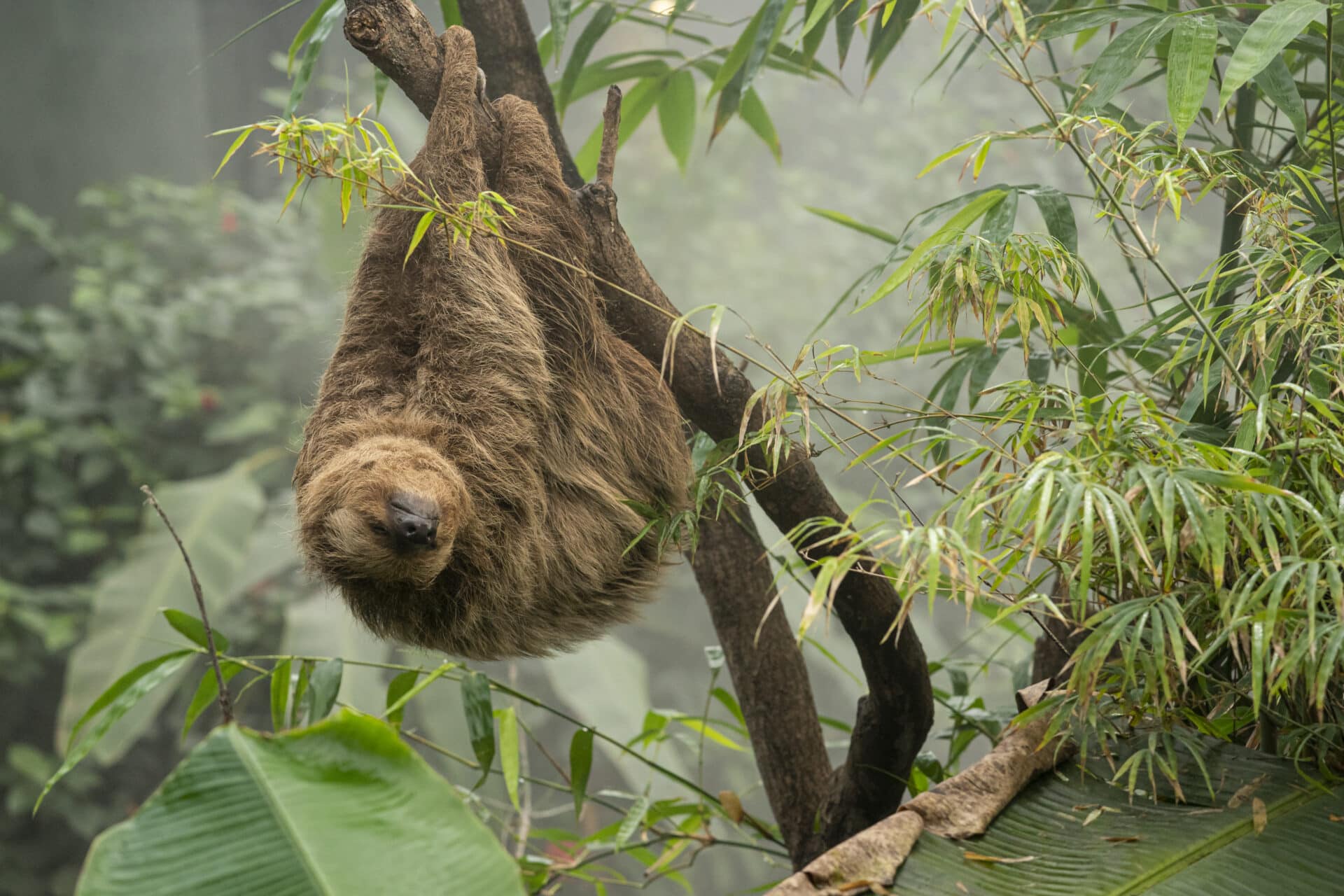Linné’s two-toed sloth
Common name: Linné’s two-toed sloth
Scientific name: Choloepus didactylus
With a reputation for being slow, these unusual energy-saving mammals live life upside-down, their bodies and behaviours adapted to their tropical, tree-dwelling (arboreal) lifestyle.
They have long front and hind limbs that are almost equal in length, and are covered in shaggy pale brown fur, apart from their face. This fur can sometimes be tinged with green due to the algae growing in it. Amazingly, each hair has a specialized groove along it which may encourage the growth of the algae in their fur. This is thought to help with their camouflage and perhaps also nutrition as they may eat the algae, or may absorb nutrients from it through their skin. Several different species of invertebrates and fungi, as well as the algae, can be found living within or on the long hair of sloth.
This long hair (up to 17cm) has a parting along the stomach, flowing towards the short tail. Scientists think this helps rainwater to run off while the sloth is hanging upside down, so it doesn’t puddle on their stomach area. Since sloths spend a lot of their time upside-down, hanging below branches, they have high blood pressure to keep the limbs supplied with blood, as their heart is positioned below their limbs when they are upside-down. They tend to move slowly with an effortless hand-over-hand motion, although they can move quickly too. They don’t usually spend more than one day in the same tree, and are generally nocturnal, moving around more overnight.
At 4 – 11kg, the Linné’s two-toed sloth are the largest of the 6 sloth species, which are separated out into 2 families of either two-toed or three-toed species. However, the so called two-toed species, the Hoffmann’s and the Linné’s two-toed sloth, actually have three digits or ‘toes’ on their hind limbs. It is the front limbs that only have 2 digits. Whereas in the three-toed sloth species, both the front and hind limbs have 3 digits. Misleading commonly used names show the importance of everyone using the same scientific name (e.g. Choloepus didactylus) for a species to avoid confusion. The digits on each limb are fused together with skin (syndactylous), so actually only look like a single appendage anyway, but you can still tell how many digits there are underneath by counting how many of the 7.5 cm long, hook-like claws there are.
Fast Facts
-
Status
Least Concern
-
Size
54-88 cm in length (Males and females similar)
-
Weight
4-11kg
-
Gestation
10 – 11 months
-
Number of young
1
-
Lifespan
30 - 40 years

In the wild
Sloths are primarily herbivores. They use their long forearms to pull leaves, tender twigs, flower buds and fruit towards their mouth to eat. They may also eat any insects or eggs that they come across. This is a high fibre but low nutrient diet, which requires specialist processing or changes to reduce the body’s energy requirements.
To conserve energy they move slowly and, in most areas, spend about three quarters of a day sleeping or resting. Unusually for mammals, sloths don’t keep a constant internal body temperature but let their temperature vary which further reduces the need for energy use and intake.
Digestion is also slow – food may take an entire week to pass through the guts, and waste is stored up for their once or twice weekly toilet trips to the forest floor. This means that up to 30% of the sloth’s body weight can be made up of stored faeces and urine!
This all means that sloths only expend about half of the energy that you would expect for their size, allowing them to thrive on their low energy diet.
The Linné’s two-toed sloth lives most of its life up in the trees of the tropical moist lowland and montane forests of Brazil, Colombia, Ecuador, French Guiana; Guyana, Peru, Suriname and Venezuela, in South America. They prefer continuous forests so they can stay up in the tree canopy, moving easily between interconnecting tree crowns or by using lianas (a type of climbing vine found in tropical rainforests). They will come down to the ground though, descending head first, to get to an isolated tree that they want to feed from. They are clumsy moving on the ground and appear awkward, though they are good swimmers.
They have the lowest and most variable body temperature of any mammal (range 24°c –33°c). This varies considerably depending on the temperature of their surroundings. Sloths are therefore restricted to equatorial habitats where the temperatures are constantly warm. They change their behaviour to help regulate their body temperature, seeking shade if too hot or direct sunlight to warm up. Most sloth deaths occur during the colder rainy season, as it’s thought the lower temperatures mean they are less able to digest their food, and so starve.
Sloth toilet habits are also rather unusual. They only climb down from the protection of the leafy canopy once or twice a week to have a poo (defecate). Reducing the amount of time spent on the ground reduces the amount of time they’re at risk from ground-based predators, such as jaguars and ocelots.
Scientists still don’t know why sloths make the dangerous and energy expensive journey down to the ground to urinate and defecate, especially when many other arboreal species simply get rid of waste up in the trees and let their excrement drop down. One of the theories is that they risk the ground predators so that the moths living in their fur can lay their eggs in the sloth’s poo, completing the moth life cycle. This may benefit the sloths as having moths in their fur provides nutrients which then helps algae to grow. This algae then helps with the sloth’s camouflage and nutrition. Another theory is that leaving their poo at the bottom of regularly visited trees is an important way for sloths to communicate with each other.
Sloths spend most of their time up in the forest canopy, but they are still vulnerable there to aerial (sky) predators, like the harpy eagle. Sloth movement is usually slow though, and they remain still for lengthy periods so they generally go unnoticed. This, along with their pale brown colouring, makes them very well camouflaged. If they are spotted by predators however, they defend themselves with their long, sharp claws and teeth.
Two-toed sloth are generally solitary, except for breeding and females with their young. Sloth mate throughout the year, however, some researchers have noted an increase in mating between March and April.
After a gestation of approximately 10-11 months, the female sloth gives birth upside down in the trees to a single infant and then carry their young on their abdomen for 6 – 9 months. The infant hooks its small claws into the long fur of its mother’s front to hold on.
Young will feed on their mother’s milk for around 1 month, after which they will begin to feed on leaves. By 5 months the young will regularly feed away from its mother. It becomes independent by 9 months old and leaves its mother. However, females may stay in contact with their offspring living nearby for up to 2 years.
Although it is not known if the number of Linné’s two-toed sloths is increasing or decreasing, there are many living throughout the north of the South American continent and many of them live in areas that are protected. Some individual sloths are cared for in rescue centers after they are forced to move because farmland is created, or roads are built. These are released into a safe environment after they are back to full strength.
Linné’s two-toed sloths have been at Marwell since a female called Rica arrived in 2018. She initially lived in a specially designed part of the Tropical House, but after installing more trees, vines and ropes, she was able to move around the whole of the main level. As part of the EAZA Ex-situ Programme she has now moved on to another zoo for breeding, with her place at Marwell now taken by Santos, a young male sloth. Marwell’s sloth are fed on vegetables and concentrated pellet feed.






